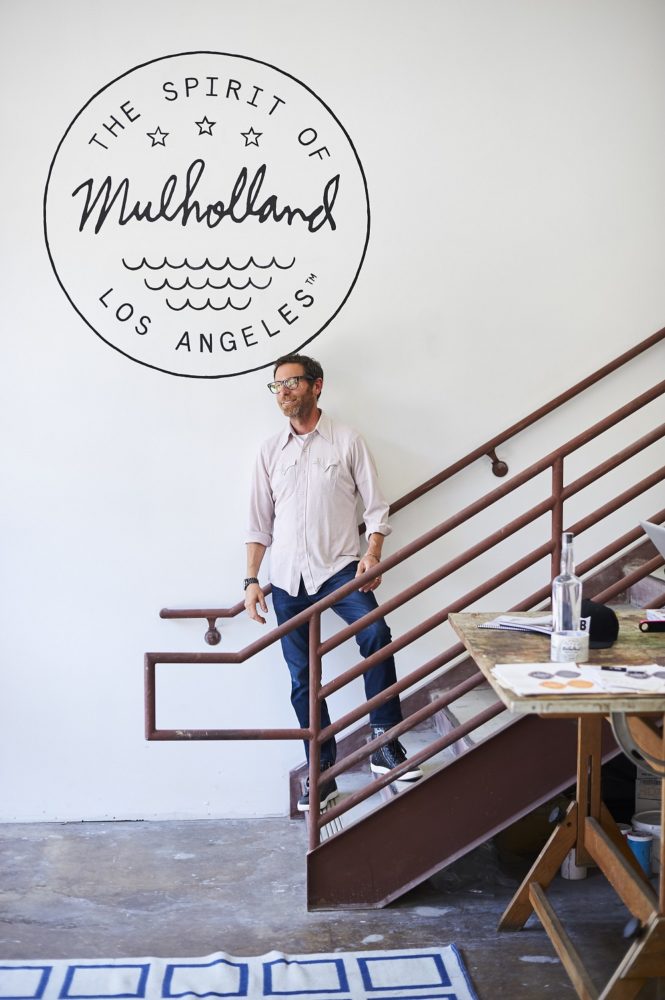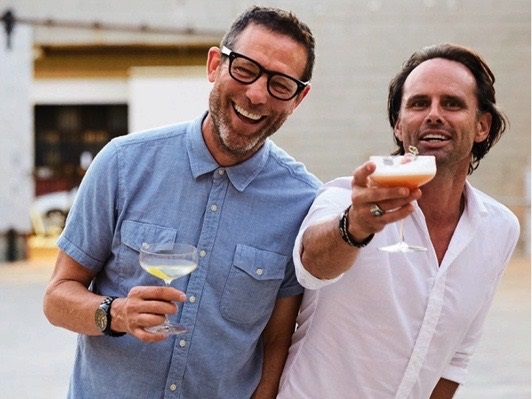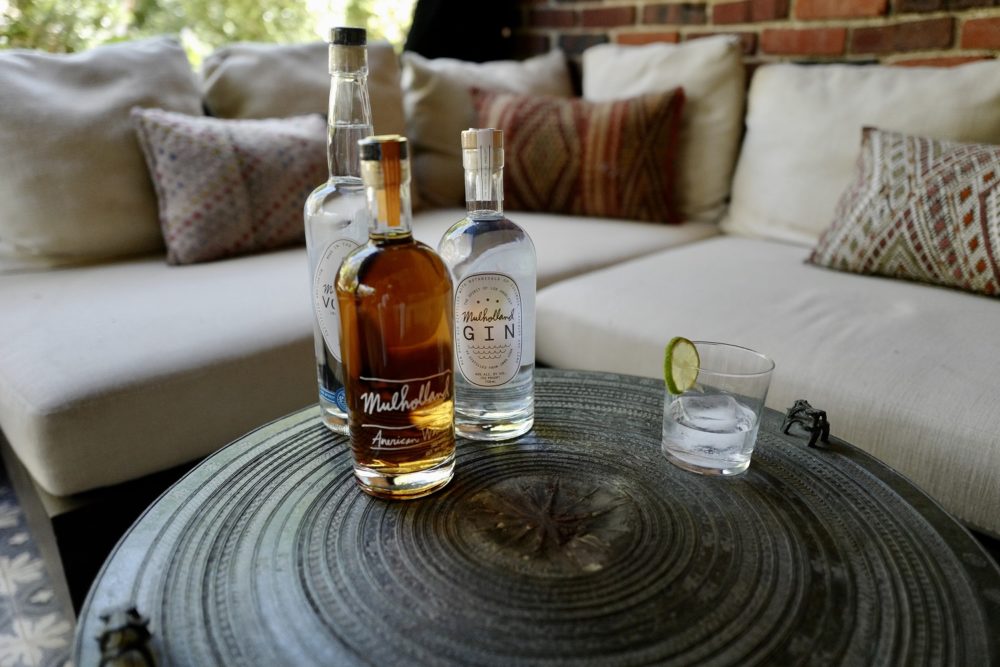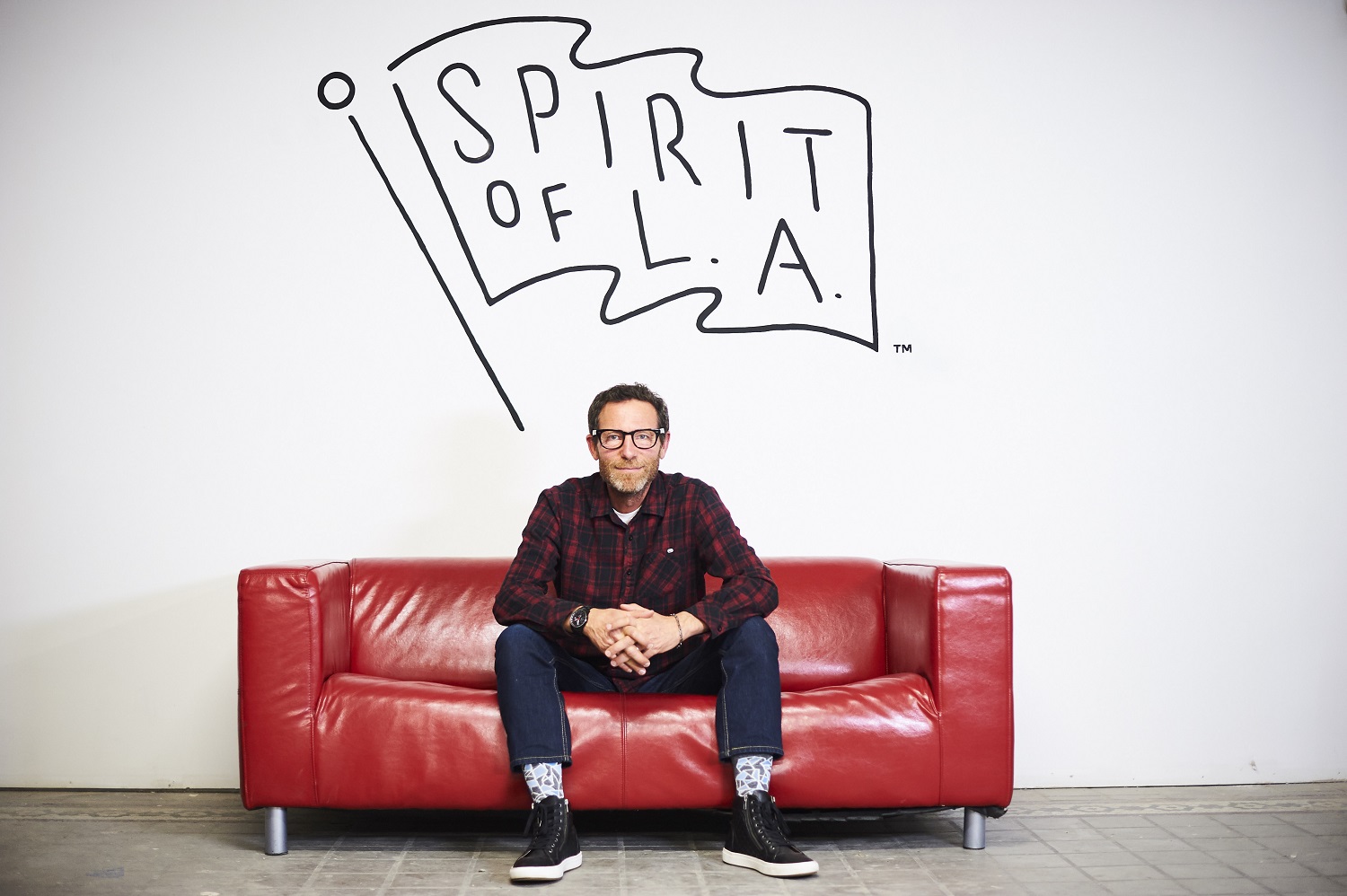
Initially, I was going to meet Matt Alper and Walton Goggins of LA’s Mulholland Distilling for an in-person interview in San Francisco. It was to have taken place in Japantown, so I began planning my driving route there. What landmarks might I share with the reader to cast the day in an appropriately urban light? Would the cherry blossom trees be in bloom? I was going to book an Airbnb I favor in the Sunset District, and envisioned myself there, sipping on a spirit late into the evening, piecing together this story after a satisfying daytime interview.
Then, suddenly it seemed, the shelter-in-place mandates went into effect and the event was cancelled. Since then the interviews I’ve conducted have been via video conferencing from the familiar yet predictable confines of my home study. I can hardly complain. We have food in the fridge. The rent and bills are paid and I enjoy spending time with my wife, so we’re some of the lucky ones who don’t mind doing just about everything from home.
Still, a first-world kind of disappointment descended upon me when I learned I’d have to conduct the interview via Zoom. Nothing against Zoom, but for all its fun backgrounds and efficiencies, it robs a potentially intimate situation of its…well…humanness – all those little physical manifestations and eccentricities that emerge when members of our species gather in the same space. I was promptly disabused of this rather bleak Zoom outlook the moment I hopped on my video session with Alper and Goggins.
Alper, in a baseball cap, was doing double-duty, helping his daughter with her school work while we talked. When Goggins hopped on the session, he had to move around a bit, trying to find a good Wi-Fi connection in his backyard as his wife was indoors with their son, helping him with his schoolwork as he attended yet another day of virtual school (virtual playground not included).
Artifice does not survive well during a pandemic. My penchant for polish and preparation during an interview went out the window the moment I accepted that my hair has gone gray and grown out. I’ve put on a few pounds lately, and I’m a bit more anxious than I used to be. Alper and Goggins, too, arrived at our video interview with an openness and vulnerability that seems part and parcel for this time we find ourselves in.

The first thing that sparked my imagination about Mulholland Distilling was the name. I spent a lot of time in Los Angeles in my twenties and thirties working the wine market there, and took many long, meandering drives on Mulholland – the kind of drives born of an impulse to hop in a car and move through a city one loves while people- and environ-watching to good music on the radio. Those kinds of drives are made for late summer nights, and on those, I’d often pull off Mulholland, up around where it cuts through Laurel Canyon, and breathe in the city’s restless, tense energy.
Mulholland Drive is named for William Mulholland, an Irish-American civil engineer, Belfast-born, responsible for building the infrastructure that allowed for water to be brought into Los Angeles, resulting in its unstoppable trajectory towards becoming the largest city in California. Mulholland Drive runs for about 21 miles through parts of Los Angeles, some of it unpaved and not frequently accessed. The most iconic sections of Mulholland Drive include where it crosses Sepulveda Boulevard, Beverly Glen Boulevard, Coldwater Canyon Avenue, Laurel Canyon Boulevard, Nichols Canyon Road, and Outpost Drive. Traveling along this circuit, an adventurous seeker will come upon any manner of shifting architectural styles, family-owned businesses with dated storefronts, trendy neighborhoods chock-full of cafés, bookstores, breweries, cannabis dispensaries and tattoo parlors – residential areas seemingly insulated from the hectic metropolis surrounding them.
Why the Mulholland name? Goggins responds, “What is the name that represents Los Angeles? What is the artery that ties this together? What is one of the most famous drives in the world? That’s Mulholland Drive. For me, a poor kid from Georgia, thinking about Los Angeles, Mulholland Drive was the first road I wanted to see. It’s the first place I went, even before I moved into that shitty apartment that I got. I drove up on Mulholland with a cold beer, thinking, ‘How the fuck did you get here, man?’ ”
Alper, a third generation Angeleno, adds that he did a deep dive while they were thinking about a name, and asked himself, “What is LA? Where did it come from? There was no natural port. No water. The person who made that possible was William Mulholland. He knew where every pipe was buried in this city. He was a rascal, raconteur, hard-working. Driven. But I don’t know how good a man he was.” Goggins adds, “I just read Marc Weingarten’s book, Thirsty: William Mulholland, California Water, and the Real Chinatown. It’s extraordinary. It’s about the early players that brought water to Los Angeles. William Mulholland was the most altruistic of all of them. He was the great equalizer. He believed in this city. He was an Irish immigrant who saw the potential in this City after living in a number of places in America. He got here and felt like, ‘I’m home. This is my home and I can do something with my life.’ He was an autodidact. Never went to engineering school. He never went to any school…and there would be no Los Angeles without William Mulholland.”
“I’m not from Los Angeles, but I’ve lived here thirty years,” Goggins adds. “And while this city has taken a lot from me – it’s taken a lot from everyone who makes this journey here – it’s also given me more than it’s ever taken away.”

Alper and Goggins have been friends for twenty years and decided to go into business together after Alper attended a Father’s Day BBQ in Hollywood that proved to be fateful. While at the party, he spied an older gentleman who intrigued him. “He didn’t look like he belonged there,” Alper says. “He was in his 60s, had on this professor’s jacket with the patches on the elbows. He didn’t think the BBQ was good. Of course that’s the guy I wanted to talk to.” They struck up a conversation over whiskey, and the gent, who turned out to be the co-founder of a distillery in North Carolina, wondered aloud to Alper why it was that Angelenos drank so much but there were no distilleries in LA. Alper says he had a “light bulb moment” then. “I was a camera guy and worked on films for years and years. I was looking for a second act, and it felt like a story I could tell better than most just from growing up here and being here.”
Gin lovers will find the traditional gin flavors of juniper and coriander in the Mulholland Distilling Gin, but aromatics of high quality, distinct French lavender, Japanese cucumber and Persian lime add unexpected nuance and pleasure. Utilizing 100% non-GMO corn, this 96 proof, gluten-free gin possesses a bracing cucumber and juniper bouquet, followed by bursts of clean and precise citrus notes on the palate. If some spirits are described as feminine and others as masculine, this gin emerges as androgynous, a balanced, approachable spirit for a broad range of imbibers. “I’m kind of a chemistry geek”, Alper says. “One thing that always struck me is that cucumber and lavender are aphrodisiac scents. They really are. They cause a response in your brain and you drop serotonin when you smell them. I really love the smell of cucumber. It’s beautiful; it stimulates. On the palate, it’s floral. For me, it was about getting people who like gin to think ‘This is a cool take on it’…and for someone like me, who likes gin but who’s not a gin guy, I wanted them to want to drink gin.”
At $19.99 a bottle, the Muholland Distilling Gin wildly over-performs.
When it comes to vodka, I’ve long been a fan of Chopin, a potato vodka, and I’m particularly fond of their Reserve Chopin, which retails for just over $100.00 a bottle. At $19.99 a bottle, the Muholland Distilling Vodka may be a new favorite. Alper and Goggins have managed to produce a vodka that is ephemeral, which is to say they’ve made a spirit that, true to its identity, is best known for what is not there. It is a clean, directed and purposeful spirit with more of a presence than a flavor profile. At 86 proof, it’s been double charcoal filtered and emerges with a faint, but noticeable confluence of evergreen and white pepper, though what the imbiber remembers is the ethereal nature of a very well-made and -blended vodka – a spirit that accompanies the ideal repast without ever demanding to be recognized. At $19.99 a bottle, it rivals vodkas four times the price. This one’s a special find.

Mulholland Distilling might be best known, though, for their whiskey. For me, Yamazaki 12-Year-Old Whisky has become a favorite. Admittedly, though, it’s expensive, so I enjoy it as a rarity, a special occasion whiskey. For years I’ve been looking for a staple whiskey that wasn’t so costly. Maker’s Mark Bourbon Whiskey has served me well, but the Muholland Distilling Whiskey is a revelation at $32.00 a bottle. The mash bill consists of 94% corn, 4% rye and 2% malted barley. The approachability on the nose and palate is due perhaps to a nearly ghostly suggestion of vanilla bean and sweet corn. So faint are these aromatics that they never detract from the heart of this whiskey, which offers itself up within the contours of herbal rye, dried apricots and forest floor. It’s entirely unfiltered, which lends the aromatics and flavors a specificity that is more than welcomed.
When I ask Alper about how he blends this whiskey, he says, “I know what I like in whiskeys; I know what I like in entry level, and I know what I like in the fancy stuff. But I really made an effort to imagine myself just sitting with a friend and having a sip, and what tastes good and what makes me happy. I’m not going to sit there and break it down and analyze it, as we do with wine when pairing it with food. At the end of the day, when you’re sharing it with a friend – the stories, the thoughts – this is just adding to the experience. I’m gonna do what makes me feel good and I will make my friends feel good. Maybe it will make other people feel good as it gets out into the broader world.”
“He’s been collecting whiskey and spirits for many years before even starting this because of his love of imbibing,” Goggins says of Alper. “The same with me; while I didn’t collect, I damn sure drink and I love it. I absolutely love it. For me, drinking has always been associated with conversation, with literature and art. And so it wasn’t a spirit that inspired me, it was a lifestyle of people I saw in photographs who ended a day with a celebratory drink about what they had accomplished, or what they had experienced during their travels on any specific day. For me, I always wanted to see myself in those pictures – from the time I was a small kid – I saw myself in the world, drinking in some foreign country, talking about my exploits. And I, through the grace of God and through hard work, manifested that. I wanted to be involved with Matt and build a brand that reflects that image – the way that people want to see themselves – that would fit in their hands at a price point they could afford. And you don’t need to spend $50 or $60 dollars on a bottle of whiskey or $45 dollars on a bottle of gin to talk about the end of a beautiful day you’ve had. It shouldn’t be like that. If you give people a high aesthetic for an affordable price, then they will come.”
Oftentimes, when it comes to pricing a spirit or a wine, producers engage in long, drawn-out conversations and considerations. After they’ve come up with a baseline price, ensuring they’ve at least covered all their costs, the profit discussion comes next: Should I price my spirit or my wine super high so that I’m taken seriously? Respected? Collected? Still others ask themselves, Who do I want drinking my stuff and do I want to make something affordable so that more people can enjoy it? If it’s affordable, will that ding my ego, or will I be proud of that fact? These seemingly simple questions can result in months, if not years, of deliberation. As someone who is not only comfortable toggling between high and low brow culture but revels in the interplay found there, I prefer approachable price points that over-deliver on quality. The producer’s choice displays a rare confidence. When I ask them about the pricing on their line of spirits, Goggins says, “It’s sophistication that is affordable,” he says. “I’ve never been a guy inside the velvet rope. Ever. I’ve waited for people to wrap the rope around me. I’m still waiting to get an invitation behind the velvet rope. We just live our lives and be as honest and as forthright as possible,” he says.
Inevitably, the three of us find ourselves talking about the culture of spirits and how each of us enjoys them. “If I’m really being honest with you, it is in a foreign country, on a really far flung beach, in a shitty little abode that’s about $30 dollars a night, listening to music on my little speaker and drinking alone,” Goggins says. “Honestly, that is one of my happiest moments in my life. I’m an only child. I’m good at being alone even though I love my family and I love my friends. But when I’m having a couple of cocktails in the middle of nowhere, listening to really good music is maybe my happiest time.” Goggins says he likes to listen to “Tom Waits, early Waylon and Ethiopian jazz – Mulatu Astatke – and I’ve been listening to Chelsea Hotel a lot.”
In Alper’s perfect imagined moment of imbibing, he’s similarly alone, “It’s funny, about being alone in a particular place at a particular time. Spaulding Gray used to talk about these ‘perfect moments’. For me, it’s a glass of tequila, with a little sangrita on the side, on a beach in Mexico. I’m in the pool and there’s nobody around. The birds are singing. Just the bougainvillea and the flowers. Everything is so amazing. It’s that moment when you’re sipping tequila and feeling the joy in life.”

I share with them that my favorite place to drink spirits is on my back porch. While there are few things I enjoy more than sharing dinner and a bottle of wine with my wife, I relish sipping on a spirit alone, as the sun sets, on our badly worn wooden deck. Like many folks, I not only relish regular moments of solitude, I find them vital to my particular stripe of “self-care”. And so on quiet evenings, as an invisible chorus of birdsong penetrates the gloaming, I enjoy sitting back and sipping, slowly and judiciously, on a distilled spirit. So often it really is about the little things. “As social as sharing a cocktail is; that culture around it, there’s nothing like doing it alone,” Alper adds.
Alper, who is a cameraman (Avengers; Prime Suspect; Parenthood; Fast and Furious; Liar, Liar; Midnight Run) says of his partnership with Goggins, “We’ve been friends for over twenty years. We’ve shared some really seminal moments. Our marriages. Our kids being born. Mulholland for me, probably more than anything, has created a time when I get to see my friend regularly. I wouldn’t do it with anyone else.” Goggins, who is an actor (Justified, Sons of Anarchy, The Shield, The Unicorn, The Righteous Gemstones) says, “I wouldn’t either.”
The Mulholland Distilling portfolio of spirits is widely available at select retailers nationwide, and at Wine.com and Amazon.com, among other platforms.

